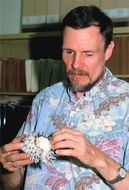If the history of life were to play out again from the beginning, it would have a similar plot and outcomes, although with a different cast and timing, argues UC Davis paleontologist Geerat Vermeij in the new paper, Historical contingency and the purported uniqueness of evolutionary innovations, in the Proceedings of the National Academy of Sciences.Evolution at this level, like the rest of history, is predictable, perhaps more predictable than people want to imagine," Vermeij (below) said. "Many traits are so advantageous under so many circumstances that you are likely to see the same things again and again.
Vermeij's view contrasts with that put forward by the late Stephen Jay Gould and others, who argued that the history of life is so dependent on improbable events and includes so many possible paths that the chances of repetition are vanishingly small. Vermeij argues that some innovations, such as photosynthesis, plant seeds, mineralized bones and
 even human language are just such good ideas that they would reappear, although at different times and in somewhat different forms.
even human language are just such good ideas that they would reappear, although at different times and in somewhat different forms.Vermeij reviewed 23 evolutionary innovations thought to be unique, including the genetic code, sex, human language and feathers, and another 55 that turn up repeatedly. Most of the unique innovations -- with the exception of human language -- are ancient, more than half a billion years old. Many of the repeated innovations are known only from a few specimens that were part of much larger groups. Vermeij said that many of life's "unique" developments might just appear to be so because other species died out and were not preserved as fossils.
A "unique" innovation might also be the result of intense natural selection. For example, once the genetic code appeared, primitive organisms readily swapped genes, as bacteria still do today. Any variants or competitors to the genetic code that arose later would have been unable to spread and establish.